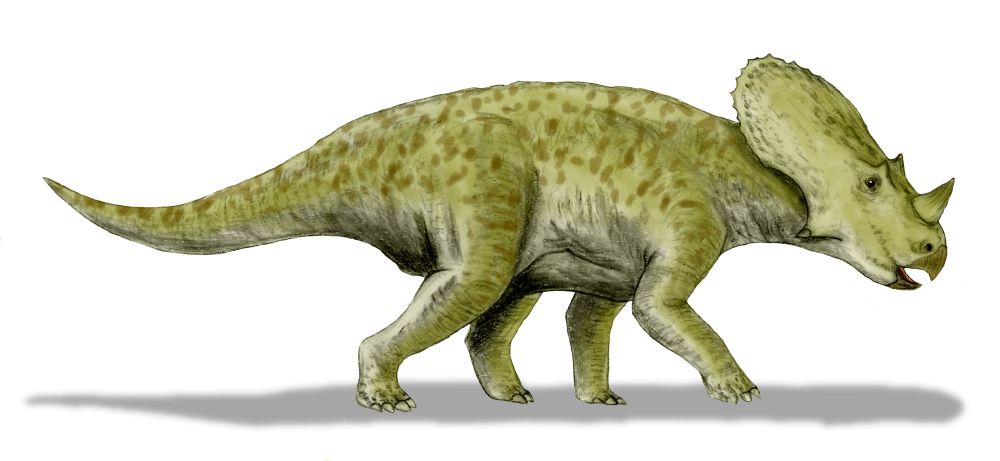- Brachyceratops
Taxobox|
name = "Brachyceratops"
fossil_range=Late Cretaceous

image_width = 200px
image_caption =
regnum =Animal ia
phylum = Chordata
classis =Sauropsid a
superordo =Dinosaur ia
ordo =Ornithischia
subordo =Marginocephalia
infraordo =Ceratopsia
familia =Ceratopsidae |
genus = "Brachyceratops"
genus_authority=Gilmore, 1914
subdivision_ranks =Species
subdivision =
*"B. montanensis" Gilmore, 1914 (type)"Brachyceratops" (the name meaning 'short horn-face' is derived from Greek "brachy-/βραχυ-" meaning 'short', "cerat-/κερατ-" meaning 'horn' and "-ops/ωψ" meaning 'face')) is a
genus ofceratopsian dinosaur . It lived during the LateCretaceous Period. Its fossils have been found inAlberta ,Canada andMontana ,United States . Scant remains composed entirely of juveniles leave much to be learned about this animal, leaving even an adult size estimate being difficult to make.Discoveries and species
"Brachyceratops montanensis", the
type species , was a somewhat rare ceratopsian species discovered in theTwo Medicine Formation (about 74 million years old) on aBlackfoot Indian Reservation in north-centralMontana . The original find was made in 1913 by C. W. Gilmore and was described one year later.All that was found were incomplete and jumbled remains of five juvenile individuals of about 1.5 m (5 feet) in length. It has been speculated that these juveniles may have been nest mates that stayed together after hatching.
As "Brachyceratops" is known only from the remains of five juveniles (plus a subadult that Gilmore found about a mile from the original specimens that he also attributed to "Brachyceratops"), it is possible these are actually the immature forms of a known
centrosaurine ceratopsian . These fossils are currently at theSmithsonian Institute inWashington D.C. kull
Among the five original specimens only one skull was discovered, and it was detached from its owner's body and fragmented. Despite this, the skull showed that the animal had small bumps over the eyes rather than horns like in the more famous ceratopsians such as "Triceratops". The nasal horn that was thick and low, while its neck frill was moderately large. Unfortunately the specimen was incomplete so it cannot be determined if there were openings in the frill like some other ceratopsians possessed.
Classification
"Brachyceratops" belonged to the Ceratopsia (the name is Ancient Greek for "horned face"), a group of herbivorous dinosaurs with
parrot -like beaks which thrived inNorth America andAsia during the Cretaceous Period, which ended roughly 65 million years ago. All ceratopsians became extinct at the end of this period.Diet
"Brachyceratops", like all ceratopsians, was a
herbivore . During the Cretaceous, flowering plants were "geographically limited on the landscape", and so it is likely that this dinosaur fed on the predominant plants of the era: ferns, cycads and conifers. It would have used its sharp ceratopsian beak to bite off the leaves or needles.ee also
Related animals
* "Avaceratops "
* "Centrosaurus "
* "Monoclonius "
* "Styracosaurus "
* "Pachyrhinosaurus ""Brachyceratops." In: Dodson, Peter & Britt, Brooks & Carpenter, Kenneth & Forster, Catherine A. & Gillette, David D. & Norell, Mark A. & Olshevsky, George & Parrish, J. Michael & Weishampel, David B. "The Age of Dinosaurs". Publications International, LTD. p. 133. ISBN 0-7853-0443-6.]Further reading
*
* [http://www.dinosaurvalley.com/Visiting_Drumheller/Kids_Zone/Groups_of_Dinosaurs/index.php Groups of Dinosaurs] at Visiting DrumhellerReferences
Wikimedia Foundation. 2010.
